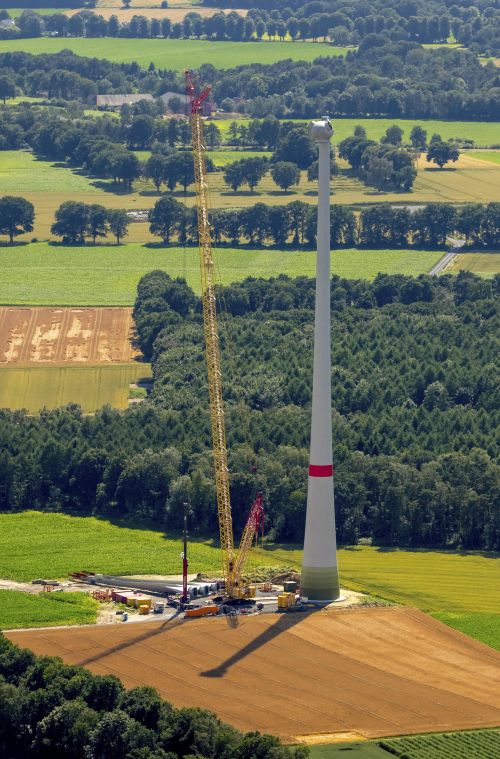Energy efficiency
Quantum leap for climate protection

Most countries have only recently begun to discover energy efficiency as a resource in its own right. The International Energy Agency (IEA) now considers energy efficiency to be the most important energy source of all: “the world’s first fuel”. But especially developing countries are hardly tapping this potential yet.
Energy demand is set to increase dramatically in countries like China and India or the Middle East region. The consequences for the environment and climate may be dire, and the additional demand cannot be met from renewable sources.
The advantages of energy efficiency are obvious. It increases competitiveness and creates opportunities for economic growth. Emerging markets and developing countries benefit from joining in the market for modern technologies. In addition, more effective use of available resources will reduce the dependence on energy imports and the need to invest in energy generation, distribution and storage. At the same time, savings gained through efficiency can be used to improve supply. The UN started the initiative “Sustainable Energy for All,” (SE4All) with the goal of doubling the global rate of improving energy efficiency by 2030. Energy efficiency definitely offers a cheap way to reduce carbon emissions (see box).
There are many technological options for improving energy efficiency. In thermal power plants, for instance, they include more efficient steam turbines and more co-generation of heat and power. Moreover, it makes sense to reduce transmission and distribution losses of power and heat.
Nonetheless, it is even more important, to consider the demand side. Energy consumption matters – so sectors like industry, trade, buildings and transport must be considered. This is where some 70 % to 90 % of economically-viable energy saving can be made.
In industry and manufacturing, reliance on more efficient electric motors, pumps, refrigerators, compressed air, heating, lighting et cetera can reduce energy consumption by 10 % to 30 %. The devices tend to be expensive, but costs can normally be recovered in one or two years due to a reduced electricity bill. Electric drives, which make up around 70 % of industrial power consumption, are especially relevant. Up-to-date, efficient drives cost around a fifth more, but savings are likely to make up for the additional costs in a few months.
Buildings account for the largest share of global energy use: about a third of the total. There is considerable saving potential in air conditioning, heating, lighting and electric appliances like refrigerators or communications technology. The scope for savings depends on a country’s climate and the quality of its building stock.
In Eastern Europe, for example, numerous buildings are in need of renovation. Improving insulation and making heating more efficient (with condensing boilers, thermal heat pumps and thermostats for example) would achieve big efficiency gains. In warmer climates, air conditioning systems are the major challenge. Much energy could be saved through insulation, reliance on shade and natural ventilation or more efficient cooling systems.
Air conditioning is of particular relevance because demand for cooling is set to grow fast in developing countries and emerging markets. Experts expect a rise of 300 % to 600 % by 2050. At the global level, greater energy efficiency in newly constructed buildings could result in energy savings of up to 50 %, and costs can be amortised within ten years.
The transport sector accounts for around 30 % of worldwide energy use. The Intergovernmental Panel on Climate Change (IPCC) warns that greenhouse-gas emissions from transport might rise by two-thirds by 2050. Potentially large efficiency gains can be made by relying on up-to-date fuel and engine technologies and by expanding public transportation, including trains. Bike paths help, and integrated urban planning can also contribute to changing consumer and commuter behaviour.
Investment barriers
The sums invested in energy efficiency must increase massively, otherwise some two-thirds of the world’s energy-saving potential cannot be tapped. So far, the European Union, North America and China are expected to invest the most. Unless developing countries improve their investment climate considerably, they will only see a small share of total investments.
Emerging markets and developing countries currently lack appropriate and reliable laws and regulations. Frequently, they have no binding efficiency standards for new buildings or electronic equipment. Moreover, many governments fail to understand the issue’s urgency. Even though energy security and energy independence are important policy goals, governments tend to focus mainly on producing energy and expanding electrification, neglecting options to boost efficiency.
In many countries, comprehensive measures to improve energy efficiency in the electricity sector are not an option because power stations and networks cannot be taken offline for several months without increasing risks of power outages. The utilities concerned, moreover, tend to be subsidised. Their tariffs do not cover their costs, so they are not in a position to finance efficiency measures from their own revenues.
Energy subsidies – especially fuel subsidies – are a huge problem because they make investments in energy efficiency unattractive due to the artificially low energy prices (see essay by Anthony Jude in D+C/E+Z 2014/11, p. 410 ff.). The lion’s share of global subsidies for fossil energy is being spent in emerging markets and developing countries.
Investors, moreover, tend to want to break even fast when they consider energy efficiency. Commercial banks equally shy away from granting long-term loans. However, it frequently takes expensive, long-term investments to boost energy efficiency. The costs can only be recovered over a number of years as a result of the reduced energy costs.
Short-termism among investors is a particularly big problem in developing countries. Companies tend to postpone even highly profitable investments in energy efficiency in favour of other business investments that break even faster. It matters that their access to credit is rather limited.
In the public sector, tendering can be a problem. Public tenders tend to prioritise low procurement, so extra spending on energy efficiency is a disadvantage even though it results in lower operating costs. Energy use and costs should be considered over a project’s life cycle.
Changing consumer behaviour
Convincing users to save energy is difficult in developing countries since the topic is not always well understood from a technical and an economic point of view. At the same time, the basics for broad-based awareness raising and promotion programmes must yet be put in place:
- Many countries have too few competent energy advisers. They need specialised service companies or experts with know-how. Typically products with certified energy efficiency such as insulation and other building materials, LEDs or industry drives and pumps tend to be unavailable.
- Little-developed markets lack transparent and standardised methods for checking, measuring and certifying energy savings. Such methods are indispensable for a systematic promotion policy.
- Energy-efficiency standards need to be defined for buildings, electrical appliances or industrial activity, and meeting them should become a precondition for financial subsidies.
Nearly all developing countries lack capital, and long-term loans are not available either. This applies especially to private households and small and medium-sized enterprises (SMEs). In 2010, KfW commissioned a survey which showed that, even in Germany, insufficient financing is the biggest obstacle to tapping SMEs’ energy saving potential.
Funding and know-how
For many years, German development policy has been supporting energy-efficiency measures in developing countries and emerging markets. The focus has been primarily on improving the investment environment and on facilitating access to financial services.
The portfolio of KfW Development Bank, which carries out projects on behalf of Germany’s Federal Government, has had a clear trend in recent years: energy efficiency is becoming more and more important. KfW Development Bank supports a variety of approaches, financing individual measures or comprehensive solutions. It is financing numerous projects on the power supply side (mainly transmission networks) while at the same time increasingly paying attention to the demand side. The KfW Group’s domestic experience in these matters is proving useful internationally.
One focus of KfW’s engagement is to renovate public buildings like schools, hospitals or health centres in countries like Montenegro, Turkey, Jordan, Morocco or Egypt. In places where there is still little incentive for private investors to spend money on energy efficiency, goals can be achieved by funding energy efficiency in public institutions as a first step.
State agencies have in contrast to private stakeholders a fundamental interest in energy-efficiency measures because it contributes to reducing subsidies. Moreover, the renovation of buildings serves other development goals, such as better learning conditions in schools and universities. The public sector is extremely important in terms of energy efficiency because it is a role model and paves the way for the private-sector market to evolve.
KfW Development Bank cooperates with numerous financial-sector institutions around the world. It provides partners with long-term, low-interest credit for measures related to energy efficiency. Partner banks can thus offer their clients loans for relevant measures. The KfW approach is stimulating demand for investments in energy efficiency and the bank helps to introduce innovative financial products, allowing commercial banks to enter a new line of business.
It is not enough to simply make refinancing available at low costs. KfW’s partners deserve advice on expanding their expertise. Relevant issues include designing new credit programmes, evaluating investment risks, identifying opportunities and calculating the potential for saving energy and reducing emissions. Procedures should be kept simple, so bank employees are motivated to use them and are able to convince clients.
In cooperation with India’s National Housing Bank (NHB), a public-sector institution, KfW Development Bank is promoting energy efficiency in Indian buildings. Based on KfW’s experience, both banks have designed a programme to finance new, energy-efficient buildings. They have designed a tool for calculating energy usage in buildings and a certification system. They are also briefing architects, engineers and bank staff. To date, 22,000 new apartments have been certified as low-usage.
In Mexico, KfW Development Bank and other international donor agencies are involved in EcoCasa, an energy-efficiency pilot programme. It supports the building of low-energy houses as well as the use of modern technologies like facade cladding, insulation or solar panels.
Setting the course
The battle against shortage of energy in developing countries and emerging markets will not be won without improving energy efficiency. Neither will the quantum leap to climate protection be possible. So far, too many developing countries are not taking advantage of energy efficiency. The topic deserves to be higher up on the development agenda.
More must be done to raise awareness among energy consumers and to clear the path for long-term investment in industrial plants and buildings in emerging markets and developing countries. The way forward is to design broad-based financing programmes that involve government-run development banks as well as financial institutions in the private sector and that expand all parties’ expertise. Obviously, the governments of developing countries and emerging markets must create the appropriate investment environments. In particular, they must cut subsidies for energy and set binding energy-efficiency standards.
Stephan Opitz is a KfW director and member of the management committee of KfW Development Bank.
http://www.kfw.de








